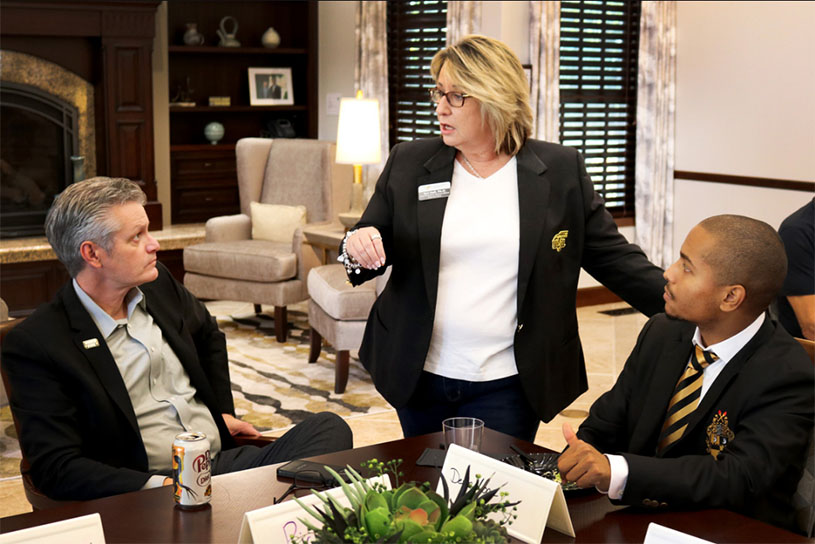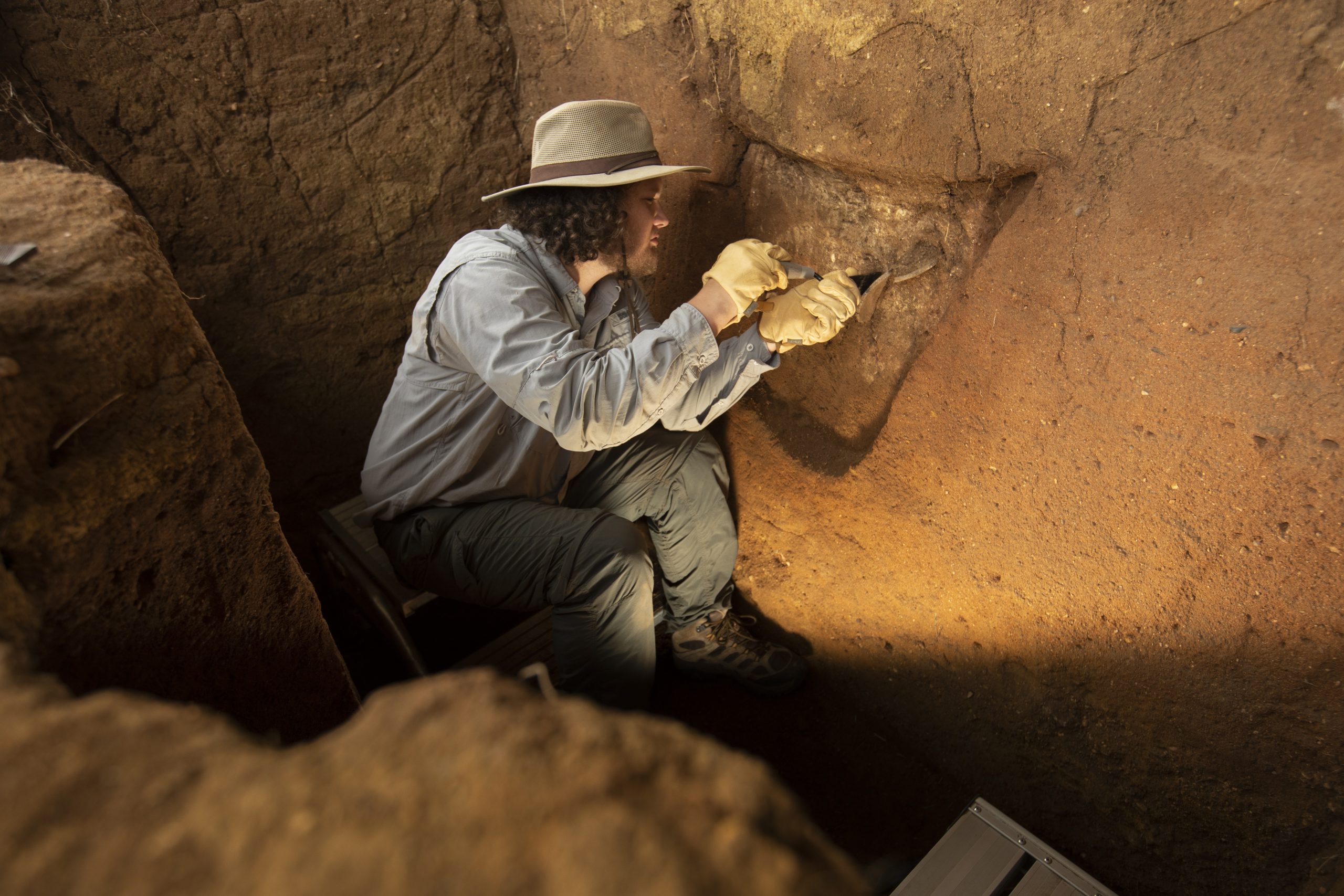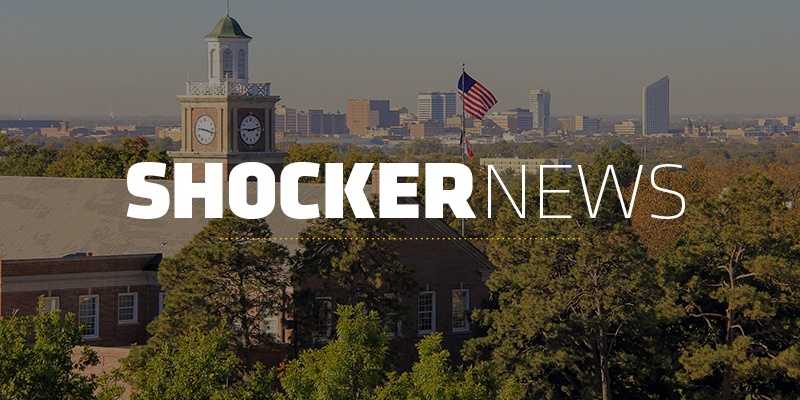Vital Signs

It’s no coincidence that Wichita State University, led by President Richard D. Muma, has six priority pulse points. There are, after all, six vital signs.
By Connie Kachel White
Notwithstanding his three decades of experience as a professor, administrator and physician assistant (PA) in internal medicine and infectious diseases, Rick Muma isn’t the first Wichita State president to see the university he was charged to lead on May 6, 2021 as a living, breathing organism.
Back in 1999, the year WSU’s 12th president took office, Don Beggs likened the university to that of a biological organism, explaining, “I see us as constantly changing, constantly modifying and learning about ourselves and growing — growing in terms of our ability to provide new experiences in learning.”
But Muma is the first of the university’s 15 presidents to be so uniquely qualified to oversee its health.
HEART RATE
Born in Wichita, but raised in Houston, Texas, a middle child with two sisters, Muma became a PA and worked in hospitals in the Houston-Galveston area, his early interest in anatomy and physiology having drawn him to the profession. “I spent the first 10 years of my career caring for HIV patients,” he says. “I was one of the first PAs in the country to develop this expertise at the beginning of the AIDS epidemic.” That experience was helpful when he took up the mantle of the WSU presidency amid the COVID-19 pandemic.
For his inauguration, Muma chose the theme “Inspired by the past, focused on the future.” And he is.
“To me,” he says, settling into a chair in his second-floor Morrison Hall office, “one of the presidents who’s most inspiring and interesting is Harry Corbin. He was the youngest at 32 years old when he became president in 1949, but the most inspiring thing about him was that he moved the university forward from a municipal university to a state university.”
Corbin ’40 (1917-1990) stepped down in 1963, making way for Emory Lindquist to become Wichita State’s first president. The first semester as a state school in 1964, tuition dropped by 35 percent and enrollment jumped by nearly 50 percent. Although the current educational landscape is distinctly different from those early years in the state system, there are strong parallels: both periods are characterized by transition, not always seamless, and transformation, not necessarily easy.
Today, the university’s top goal — its heart rate, if you will — is to provide affordable, accessible education to all. “Over the past several years,” Muma says, “we’ve been doing big things, meeting students where they are and providing a great student experience.”
RESPIRATORY RATE
This fall, Wichita State bucked the trend in falling enrollment at universities in Kansas. By headcount, combined enrollment across all WSU locations was 21,942, according to data released Sept. 29 by the Kansas Board of Regents. For the main campus, the numbers represent an increase of 5.1 percent to 16,921. At WSU Tech, student headcount increased 3.9 percent to 5,021. WSU’s credit hours stood at 168,526, up 3.4 percent from last year, the highest credit-hour total in the university’s 126-year history.
First, Muma commends every WSU administrator and faculty and staff member who had a hand in helping increase enrollment — for their hard work and genuine focus on students. He then points out a few items of interest within the data. Actually, he points out many, but here’s a sample: Some 16 percent of undergraduate students identify as Hispanic, which qualifies WSU as an Emerging Hispanic Serving Institution. Among freshmen, 47 percent are first-generation. There was a 25.2 percent increase in graduate students, the highest in WSU history.
Although there are innumerable reasons, some measurable, many not, for the rise in enrollment, one underlying cause, Muma believes, is the university-wide dedication to applied learning for all students, which is Wichita State’s second priority.
HEIGHT
A small bust of Plato passed down from Fairmount College’s first president Nathan J. Morrison is one memento Muma keeps in his office. Another is
a little figurine of a brown horse, given to him by a student as a token of thanks some 30 years ago now. When Muma was in the classroom teaching PA students proper diagnostic procedure, he often used the adage “When you hear hoofbeats, look for horses, not zebras,” a reminder to check for common causes of sickness before the rare.
The range of educational territory a university president must be mindful of is vast. Muma reins in the distances by focusing on the big picture. “We are an urban public research university,” he says. “We’re here to help this community.”
Elevating that status with Innovation Campus R&D and initiatives like WSU’s, WSU Tech’s and the University of Kansas’ collaborative move to build a downtown Wichita, $300-million biomedical center is Wichita State’s third priority. Yet reaching for those new heights doesn’t change the university’s central purpose: “What’s foundational about higher education is the core part of general education,” Muma says. “In some quarters, there’s a misperception that this university is somehow eliminating that core. That’s not so — it’s unthinkable to do that.”
BODY TEMPERATURE

“We’re kinda boring,” Muma says about himself and First Gentleman Rick Case, a retired Farm Service Agency district director. “Rick helps manage his family’s farm in Clay County,” Muma says. “We build fence, cut thistles. When we can, we like to go to Colorado. We like to garden. We run on campus — we’re just two regular guys.”
Married for 16 years with two grown children, they share a deep commitment to WSU’s fourth goal: to prioritize university support for Title IX, Equal Employment Opportunity and Diversity, Equity and Inclusion efforts.
WEIGHT
Freedom of expression is a staple value at WSU. Supporting it through rigorous debate and sometimes difficult conversation is the fifth goal at Wichita State.
When Muma was serving as interim president in 2021, WSU hosted a virtual panel discussion that covered such weighty topics as the role of academic freedom in relationship to free speech and the benefits society reaps from the open exchange of ideas. “We have to be able to be confronted, be challenged,” Muma says. “It’s part of being a university.”
BLOOD PRESSURE
The university’s sixth priority — to overstate it a whit — is to reach out to all Shockers: alumni, donors, university friends, faculty, staff and other internal campus stakeholders, as well as government officials and education professionals and colleagues.
Having never aspired to be a university president before the doors started opening for him, Muma says he’s a bit surprised about how much he enjoys talking with people about Wichita State and its priorities and goals. One measure of his commitment to this particular goal is the number of miles he has traveled in the past year: coming up on 25,000, the circumference of the Earth.
Go ahead, ask him to share his unfettered vision for Wichita State. He just may pause, glance up thoughtfully, then look you in the eyes and, with the barest hint of a smile, reply, “Our university is going to be the premier urban public research university in the country.”
One with lots of beautiful horses, and a few zebras the likes of which we can’t even imagine yet.



